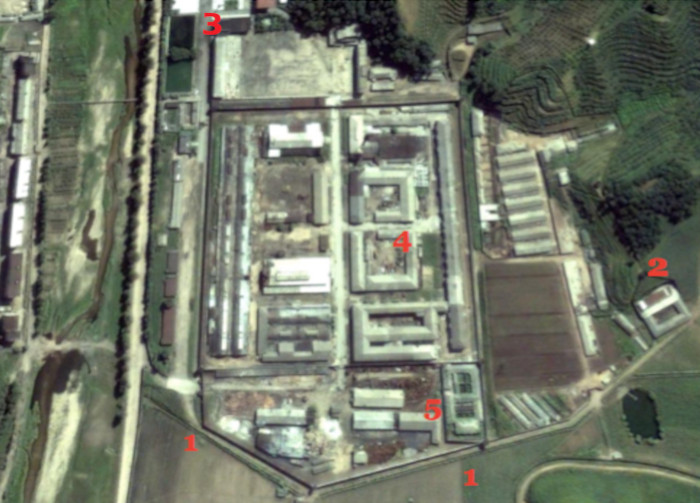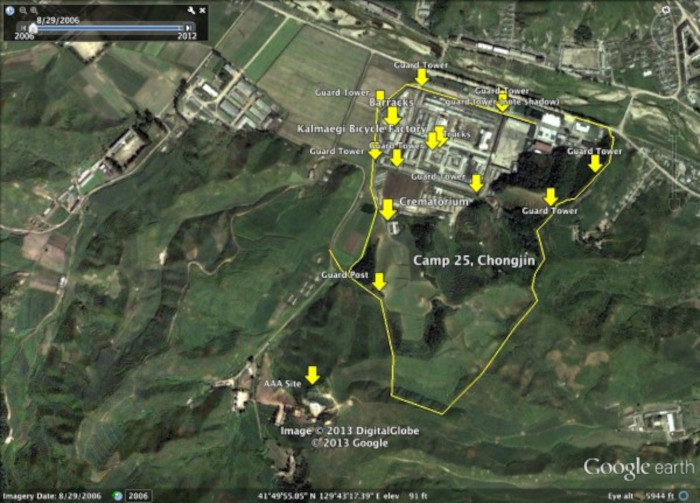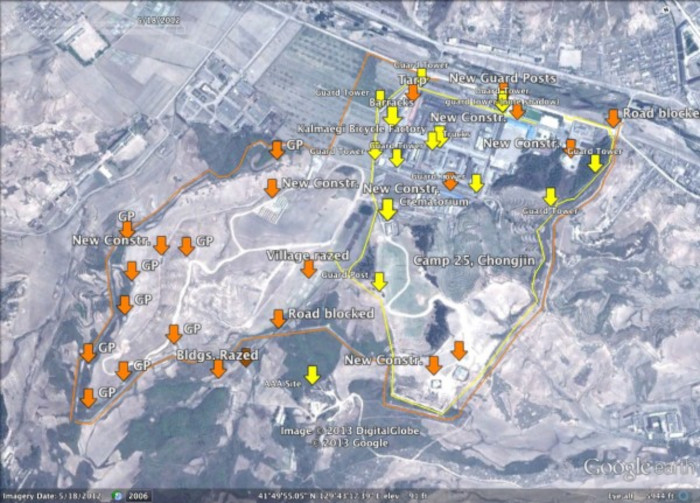
Otto Frederick Warmbier praying to God for his release from North Korean Internment.
North Korea
Continued.. 2/3
Yodok Kwan-li-so (Camp 15)
Yodok concentration camp was a kwalliso in North Korea. The official name was Kwan-li-so (penal labour colony) No. 15. The camp was used to segregate those seen as enemies of the state, punish them for political misdemeanours, and put them to hard labour. It was closed down in 2014. The colony is bound to the north by Mt. Paek (1,742 meters, or 5,715 feet, high), to the north-east by Mt. Modo (1,833 meters, or 6,014 feet, high), to the west by Mt. Tok (1,250 meters, or 4,101 feet, high) and to the south by Mt. Byoungpung (1,152 meters, or 3,780 feet, high). The valley is entered from the east by the 1,250-meter (4,101-foot) Chaebong Pass.
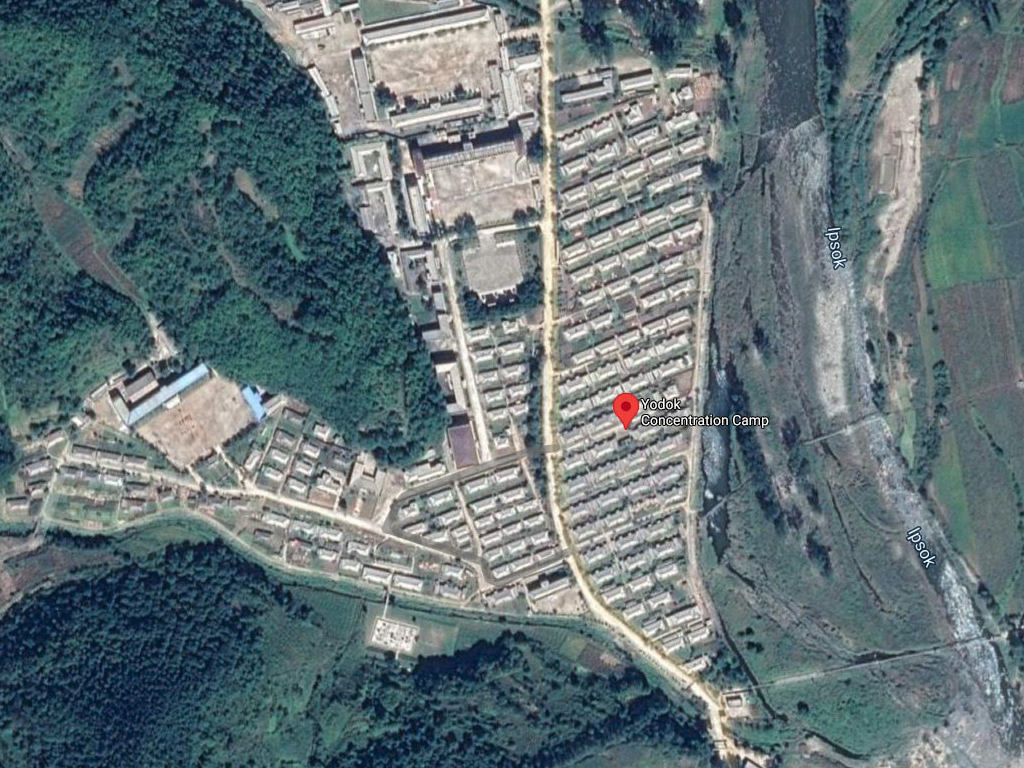
The whole encampment (378 km2 or 146 sq mi in area) is surrounded by a barbed-wire fence measuring 3 to 4 meters (10 to 13 feet) in height. In some areas, there are walls 2 to 3 meters (7 to 10 feet) tall, topped with electrical wire. Along the fence there are watchtowers measuring 7 to 8 meters (23 to 26 feet) in height, set at 1-kilometer (0.62-mile) intervals, and patrolled by 1,000 guards armed with automatic rifles and hand grenades. Additionally, there are teams with guard dogs. Inside the camp, each village has two guards on duty at all times.
Yodok camp had two parts:
- The total control zone (wan-jeon-tong-je-koo-yeok), with the prison labour colonies Pyongchang-ri and Yongpyong-ri, was for people who authorities believed had committed crimes against the regime or whom had been denounced as politically unreliable (e.g. returnees from Japan or Christians). These prisoners were never released. The Christian mission organisation Open Doors estimated 6,000 Christians to be held in the camp.
- The revolutionary zone (hyeok-myong-hwa-koo-yeok), with reeducation camps Ipsok-ri, Kuup-ri and Daesuk-ri, was to punish people for less serious political crimes (e.g., illegally leaving the country, listening to South Korean broadcasts, or criticising government policy). These prisoners were eventually released after serving their sentences.
In the 1990s, the total control zone had an estimated 30,000 prisoners while the smaller revolutionary zone had about 16,500 prisoners; later satellite images, however, indicate a significant increase in the camp's scale. Most prisoners were deported to Yodok without trial, or following unfair trials, based on confessions obtained through torture. People were often imprisoned together with family members and close relatives, including small children and the elderly, based on guilt by association (Sippenhaft).
“population of the camp in the early 1970s numbered 20,000, some 60 percent of whom were the families of the presumed “wrong-doers.”.
The prisoners lived in dusty huts with walls made of dried mud, a roof (rotten and leaking) made of straw laid on wooden planks, and a floor covered with straw and dry plant mats. In a room of around 50 m2 (540 sq ft), 30–40 prisoners slept on a bed made of a wooden board covered with a blanket. Most huts were not heated, even in winter, where temperatures are below −20 °C (−4 °F), and most prisoners got frostbite and had swollen limbs during the winter. Camp inmates also suffered from pneumonia, tuberculosis, pellagra, and other diseases, with no available medical treatment.
“The camp guards made prisoners report on each other and designate specific ones as foremen to control a group. If one person did not work hard enough, the whole group was punished. This created animosity among the detainees, destroyed any solidarity, and forced them to create a system of self-surveillance.”.
New prisoners received clothes that predecessors had worn until their deaths. Most clothes were dirty, worn-out, and full of holes. Prisoners had no proper shoes, socks, or gloves, and usually no spare clothes. The dead were buried naked because other prisoners took their possessions. All prisoners were covered with a thick layer of dirt, as they were overworked and had almost no opportunity to wash themselves or their clothes. As a result, the prisoners’ huts were foul-smelling and infested with lice, fleas, and other insects. Prisoners had to queue in front of dirty community toilets, one for every 200 prisoners, using dry leaves for cleaning.
Men, women, and children performed hard labour seven days a week and were treated as slaves. Labour operations included a gypsum quarry and a gold mine, textile plants, distilleries, a coppersmith workshop, agriculture, and logging. Serious work accidents often occurred. Work shifts in summer started at 4 a.m. and ended at 8 p.m. Work shifts in other seasons started at 5:30 a.m., but were often extended past 8 p.m. when work quotas were not met, even when dark. After dinner, prisoners were required to attend ideological education and struggle sessions from 9 to 11 p.m., where inmates who did not meet the targets were severely criticised and beaten. If prisoners could not memorise the instructions given by Kim Il-sung, they were not allowed to sleep, or their food rations were reduced.
Most of the primary school children attended school in the morning. The main subject was the history of the revolution of Kim Il-sung and Kim Jong-il. In the afternoon they carried out hard labour with very high work quotas in terms of amount and intensity. Children were beaten with a stick for failure to meet the day's quota. Primary school children had to carry heavy logs 12 times a day over 4 km (2.5 mi) or dung buckets of 30 kg (66 lb) 30 times a day. sometimes children died in work accidents. Elder children had to work all day and, from the age of 16, were assigned the same work quotas as adults.
Prisoners were constantly kept on the verge of starvation. The daily rations for prisoners were between 100 and 200 g (3.5 and 7.1 oz) of corn boiled into gruel, served three times a day. Depending on the agricultural produce of the year, rations could be less. If prisoners did not finish their daily work quota or violate minor rules, the daily rations were reduced or temporarily discontinued, no matter if they were sick, crippled, or disabled. Some prisoners sneaked into the pigsties and stole pig slops or picked undigested corn kernels out of animal faeces to survive. Lee Young-kuk estimates that at the end of the 1990s, around 20% of prisoners in Daesuk-ri died from malnutrition each year, with new prisoners arriving each month. All former prisoners say they frequently saw people dying.
Former Prisoners (Witnesses):
- Kang Chol-hwan (in Yodok 1977–1987) was imprisoned as a 9-year-old child because his family returned from Japan and was considered politically unreliable.
- An Hyuk (in Yodok 1987–1989) was imprisoned at the age of 18 because he illegally left North Korea.
- Kim Tae-jin (in Yodok 1988–1992) was imprisoned for alleged espionage after he spent 18 months in China illegally and converted to Christianity. Since camp rules prohibited gatherings of at least three people, Kim said he was tortured after he attempted to hold a meeting with other religious prisoners.
- Lee Young-kuk (in Yodok 1995–1999), former bodyguard of Kim Jong-il, was kidnapped from China and imprisoned because he illegally left North Korea and criticised the country.
- Kim Eun-cheol (in Yodok 2000–2003) was imprisoned at the age of 19 because he illegally left North Korea. He was part of a group of seven refugees repatriated by Russia; the United Nations granted them refugee status but failed to protect them.
- South Korean citizens Shin Suk-ja and her daughters Oh Hae-won and Oh Kyu-won (in Yodok since 1987, when the daughters were ages 9 and 11) were imprisoned because her husband Oh Kil-nam did not return from a stay abroad. The family had been lured from Germany on North Korean agents’ false promises two years prior. Kang Chol-hwan and An Hyuk testified to meeting Shin Suk-ja during their imprisonments.
- South Korean citizen Jeong Sang-un (in Yodok since 2010) is an unrepatriated Korean War prisoner and was imprisoned at age 84 for illegally leaving North Korea.
- Kim Young-soon (in Yodok 1970–1979) was born in 1937 in Shenyang, Manchuria (China). She was a student of famed Korean dancer Choi Seung-hee, and was for a time a member of Pyongyang's elite. After Choi and her husband were purged in 1967, Kim continued to dance, but in 1970 she was imprisoned in Yodok without being informed as to why. She was released in 1979, and only long after being released learned why she had been imprisoned in the first place. She had once been best friends with Song Hye-rim, one of Kim Jong-il's lovers, and knowing about the relationship was presumably the reason for her internment. (Kim Jong-il and Song Hye-rim's son Kim Jong-nam would later be assassinated by North Korean agents in 2017) Kim Young-soon's mother and father both died of starvation while imprisoned in the camp with her. After enduring many horrifying incidents within the camp, including the deaths of her parents, she was released and spent the next 19 years living on the fringes of society. She escaped from North Korea to China in 2001 and arrived in South Korea in 2003. One of her sons died in Yodok while young; another was shot trying to escape to China in 1989, and one was recaptured several times before finally succeeding.
Hwasong Kwan-li-so (Camp 16)
Hwasong concentration camp (spelled Hwasŏng or Hwaseong and recently renamed as "Myeonggam") is a labor camp in North Korea for political prisoners. The official name is Kwan-li-so (Penal-labor colony) No. 16. The camp is located in Hwasong County (Myonggan County), North Hamgyong Province in North Korea. It is situated along the upper reaches of the Hwasong River in a secluded mountain valley. The western border is Mantapsan, a 2,205-metre-high (7,234 ft (2.2 km)) mountain. On the north and east sides, the camp reaches the Orangchon River valley. The entrance gate is right on the Hwasong River and on the road from Hwasong, 8 km (ca. 5 miles) west of Hwasong-up (Myonggan-up). The camp is not included in maps, but the entrance gate and the ring-fence with watchtowers can be recognised on satellite images.
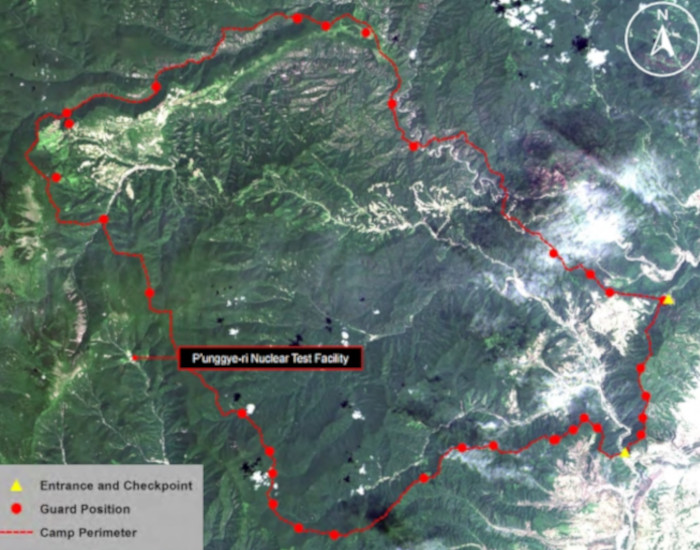

Hwasong camp is a penal-labor colony in which detainees are imprisoned for life with no chance to be released. With around 549 km2 (212 sq mi) in area, it is the largest prison camp in North Korea. Puhwa-ri (Chosŏn'gŭl: 부화리), 4 km (2.5 mi) north of the entrance gate, is the camp headquarters. The number of prisoners is estimated at 20,000. They are classified as “anti-revolutionary and anti-party elements” and held on charges such as opposing the succession of Kim Jong-il. Many of the prisoners are merely family members of suspected wrongdoers, who are held captive in a “guilt-by-association” punishment. It is believed that the camp was founded in the 1990s.
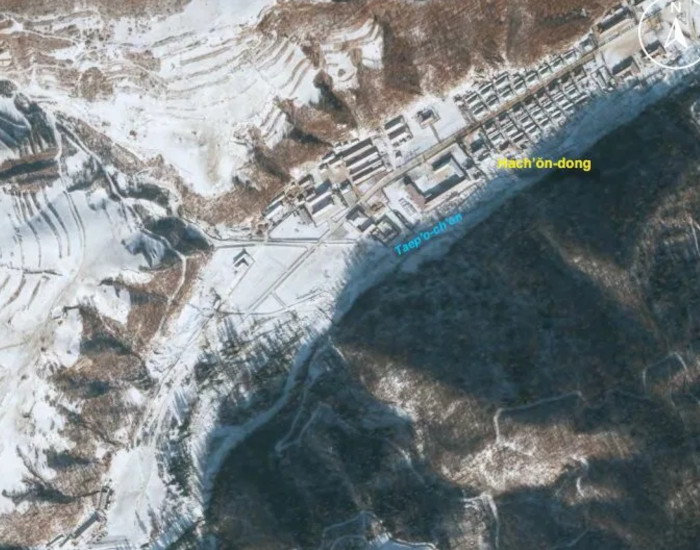
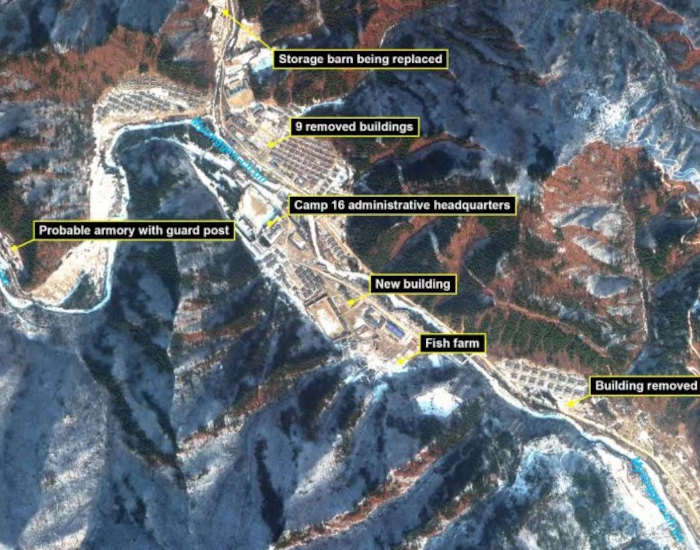
Prisoners are exploited for hard, dangerous, and deadly labour in mining, logging, and agriculture. According to Mr. Lee, a former security officer in Hwasong camp, the inmates were overworked and had very little time to rest. Prisoners had to work all day until they fulfilled their quotas and attend self-criticism meetings afterward. Often they were allowed to sleep only four hours in the night. Mr. Lee witnessed many fatal accidents in the workplace. The North Korean nuclear tests made in 2006, 2009, 2013 and 2016 at Punggye-ri Nuclear Test Site is just 2 km (1.24 miles) to the west of the camp border. Several defectors reported that political prisoners were forced to dig tunnels and build underground facilities in areas exposed to nuclear radiation.
Information is extremely limited, as the camp has always been a maximum security camp under strict control and surveillance. An unidentified teenager reported how he was sent to the camp with his entire family at age 13. He witnessed his father being beaten cruelly and his mother and sisters being raped by security officers. Residents from nearby villages heard about the horrific conditions inside the camp but were never allowed to get near the camp. Security officer Lee explained the methods to execute prisoners in an interview with Amnesty International. He witnessed prisoners forced to dig their graves and being killed with hammer blows to their necks. He also witnessed prison officers strangling detainees and then beating them to death with wooden sticks. According to him, several women were raped by the officials and executed secretly thereafter.
Former Prisoners (Witnesses)
- Besides the unidentified teenager, no former prisoner was found to provide a direct testimony, probably for fear of retribution.
- Mr. Lee (full name withheld for his safety; 1980s — mid-1990s in Hwasong) was a security officer in the camp.
Pukchang Kwan-li-so (Camp 18)
The camp is in Pukchang County and Tukchang district, P'yŏngan-namdo province in North Korea. It is situated along the middle reaches of the Taedong river, which forms the northern boundary of the camp, and also includes the mountains south of the river. On the other side of the Taedong river is the Kaechon internment camp (Kwan-li-so No. 14). here are several prison labor colonies with barracks for the prisoners and housing for the guards: the 4th, 5th, and 6th divisions. Family members are often allowed to live together. Around 50,000 prisoners live in Pukchang concentration camp. Kim Yong reported the presence of foreign prisoners, but there is no other source to confirm this.
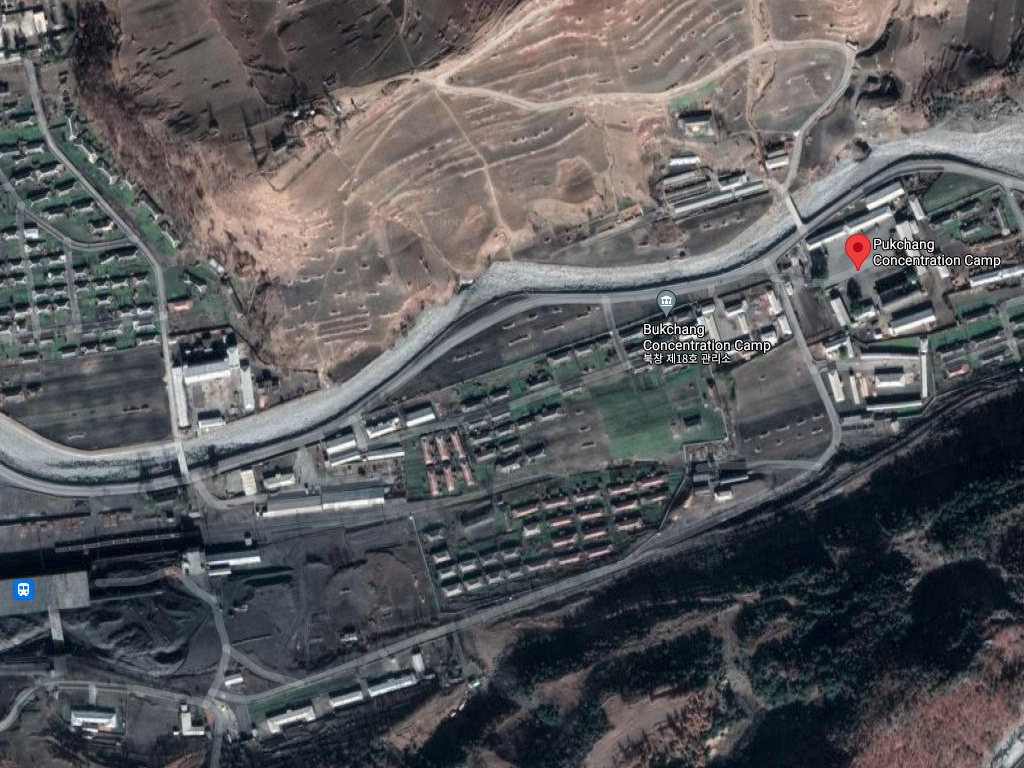
According to Hwang Jang-yop, the former leader of the Workers’ Party of Korea, Pukchang camp is the oldest North Korean prison camp and was already erected by 1958. Like in Yodok camp, there is one section for political prisoners in lifelong detention and another section functioning as a reeducation camp. Possibly, these sections were completely separated earlier and therefore are named Pukchang and Tukchang respectively. While all the other political prison camps belong to the State Security Department, Pukchang camp is run by the Interior Ministry.
Pukchang camp isolates people from society who are deemed by the North Korean government to be politically unreliable. It was established to exploit the prisoners with hard and dangerous labor. Within the camp borders, there are at least five coal mines, where all capable prisoners have to work from early in the morning to late in the evening. Furthermore, there is a cement factory and some other factories. Rules in Pukchang camp seem to be slightly less strict compared to the human rights situation in other political prison camps. Despite this, prisoners are still shot in cases of escape attempts, thefts of food, or violations of instructions. Kim witnessed more than 100 public executions per year, with prisoners being tortured and then shot or hanged as a deterrent to the other prisoners.
The most common causes of death are malnutrition, work accidents, and illnesses. Kim reported that in the 1990s, her family only received 7 kg (15 lb) of corn per month and occasionally some bean paste (Doenjang), or salt. In order to survive, they had to search for edible plants, leaves, and insects. She saw bodies lying around the camp and reported cases of cannibalism. Since the prisoners have to work 16–18 hours in the mines every day without any protection, after a few years most suffer from pneumoconiosis and many die from it. Kim developed a pulmonary tumour because of the inhaled dust. Work accidents often lead to limb amputations. Many children have frostbite because they have no shoes and have to go barefoot even in winter.
Kim reported that the prisoners have no human rights and are treated at the guards’ mercy. To humiliate the prisoners, the guards would often force them to get on their knees, and then spit into the prisoner's mouths and make them swallow the spit. If prisoners do not immediately obey, they are savagely beaten. The prisoners are monitored almost continuously by security agents and are urged to spy on each other and to denounce other prisoners.
Former Prisoners (Witnesses):
- Kim Yong (1996–1998 in Pukchang) was at first imprisoned in Kaechon camp, when his relationship (which he covered up) to his father and brother, who both were executed as alleged US spies, was identified. Later, he was relocated to Pukchang after the intervention of his former boss.
- Kim Hye Sook (1975–2002 in Pukchang) was imprisoned at the age of 13 years because her grandfather tried to escape to South Korea.
According to some sources, the camp ceased operations in 2006. The satellite images, however, show that the mine inside the camp is still operating with civilian labourers. It is likely that some parts of the camp still hold political prisoners, but most of the former camp area has stopped functioning as a labour camp. In 2016, it was reported that camp 18 had either been re-opened or merged with camp 14 on the other side of the river. Satellite images showed a new security perimeter and increased activity in the area. There also seemed to be an operational ferry between the two camps, giving the suggestion that the camps may have merged.
Camp No. 18 shared with Camp No. 15 (Yodok) a characteristic that differed from other camps such as Camp No. 14 (Kaechon), Camp No. 22 (Heoryong), or Camp No. 25 (Chongjin) in that there were prisoners at Camps No. 15 and 18 who were released, whereas at the other kwan-li-so camps, the prisoners were detained without trial and subjected to forced labor until death.36 For this reason, there are many more former prisoners from Camps No. 15 and 18 who subsequently fled to China and South Korea, and who have provided the outside world with testimony about the North Korean prison camp system.
The releases at Camp No. 18 were of a different nature, and therein lies their significance. At Camp No. 18, at various times over the last several decades, entire “villages” within the sprawling labour camp described above were de-commissioned as prison labour camps. Most of the prisoners residing in those villages were “cleared” of their wrongdoings, and their liberties—to the extent that non-elite North Koreans have liberties—were restored, including their freedom to travel or move elsewhere within North Korea.
The process was called madang haeje, “broad clearance.” Thirty-nine Prisoners in those villages who were not “cleared” were transferred to other villages within Camp No. 18 that continued to function as forced labour prison camp villages.There was a madang haeje “broad clearance” in the mid-1980s. Another “broad clearance” took place in the mid-1990s, as other villages within Camp No. 18 were decommissioned as forced labour.
A former Camp No. 18 official who defected to South Korea explained these releases:
“The reason for the release of prisoners in 1989 was that many of the prisoners were the third and fourth generation of offenders such as landlords, capitalists, collaborators with the Japanese colonial government, and other people with bad family background… In fact, the prisoners were the grandchildren of offenders, and they found the grandchildren were, in fact, innocent, and decided to release them.”.
However, while the “cleared” former prisoners were technically and legally allowed to leave, many stayed, even with their citizen rights restored—etching out a penurious existence living in their same houses and working in the same places. Essentially, these former prisoners had been detained for so long—multiple decades in numerous instances—that they had lost all contact and connection with their families, friends, and colleagues in their home villages or towns. The mines, formerly operated with prison labour, now operate as civilian enterprises. Analysis of satellite photos seems to confirm that “the fence lines of the camp are still visible, but the main checkpoints seem to be dismantled or degraded.
Chongjin Kwan-li-so (Camp 25)
Chongjin concentration camp (Chosŏn'gŭl also spelled Ch'ŏngjin) is a labour camp in North Korea for political prisoners. The official name is Kwan-li-so (Penal-labour colony) No. 25. Satellite images show a major expansion of the camp after 2010. The camp is located in the city of Chongjin in the North Hamgyong province of North Korea. It is situated in Suseong district (Susŏng-dong) of Songpyong-guyok, around 7 km (4.3 mi) northwest of the city center and 1 km (0.62 mi) west of Susŏng River (Susŏngch'on).
Chongjin camp is a lifetime prison. Like the other political prison camps, it is controlled by the state security agency. But while the other camps include many vast prison-labour colonies in remote mountain valleys, Chongjin camp is only one big prison building complex similar to the re-education camps. The camp is around 500 m (1500 ft) long and 500 m (1500 ft) wide, surrounded by high walls and fences, and equipped with guard towers. The number of prisoners is estimated to be between 3000 and 5000.
* “No. 4” is the bicycle factory, and “No. 5” is a barracks. And “No. 2?” It’s a crematorium.
“A South Korean human rights NGO showed satellite photos of this structure and its surrounding areas to several former residents of Chongjin, two of whom identified the structure in the photographs as Camp 25. One of the former Chongjin residents had gone out to the prison camp to visit a friend who was a guard there. The other former resident had driven a truck to the prison camp to pick up a shipment of the bicycles made there by the prison labourers”.
Detailed analysis of satellite images shows a major expansion of the camp perimeter in 2010. The size of the camp increased 72 percent, from 580 m2 (6,200 sq ft) to now 1,000 m2 (11,000 sq ft). Along the new fence line, 17 additional guard posts were erected. In the eastern part of the new perimeter, several new buildings were erected from 2011 to 2013, possibly to be used as prisoner housing. There are no first-hand witness accounts on the camp; however, there are some reports by North Korean defectors on prisoners in Chongjin camp. Lim Kook-jae, a South Korean abducted to North Korea in 1987 aboard the Dong Jin 27, died in Chongjin camp, according to a human rights organisation.
Chungsan Kwan-li-so (Camp 11)
The camp is in Chungsan county, in South Pyongan province of North Korea. It is in the Yellow Sea coast, around 50 km (31 mi) west of Pyongyang. Chungsan camp is a sprawling largely women's penitentiary with between 3,300 and 5,000 prisoners. Since 1999 the camp is used to detain female defectors, which account for 50–60% of the prisoners, while others are incarcerated for theft, prostitution, unauthorised trade, etc. The food rations are very small. According to a former prisoner, one third of the prisoners died from combinations of malnutrition, disease, and forced labor within a year.
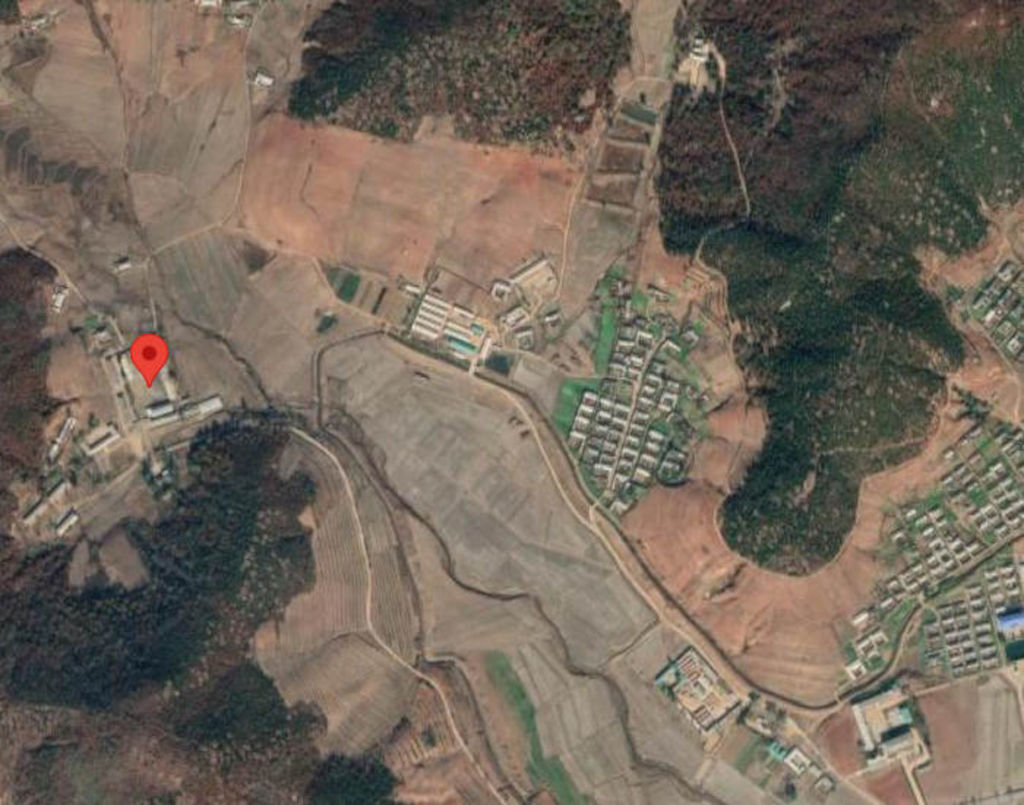
In interviews other former prisoners reported about:
- solitary confinement cells,
- hard work in farming, from 4 a.m. to 7 or 8 p.m. in the farming season,
- a strict system of control and surveillance,
- public executions,
- violent beatings in cases of rule violations.
Former Prisoners (Witnesses):
- Kim Miran (around 2002–2004 in Chungsan) was repatriated from China for illegal border-crossing.
- An unidentified former prisoner (female, 2004–2005 in Chungsan) gave testimony to HRNK about the camp. She was repatriated from China and imprisoned without a trial for illegal border crossing.
- Ten other unidentified former prisoners (all female) were interviewed by the Database Center for North Korean Human Rights. Most of them do not want to be identified for fear that their relatives in North Korea are punished.
The camp is surrounded by agricultural plots, where the prisoners have to grow rice and corn for delivery to the Ministry of Public Security. The food rations are very small. According to a former prisoner, one third of the prisoners died from combinations of malnutrition, disease, and forced labour within a year. Dead prisoners are buried in mass graves on a nearby hill. She reported that the prisoners were often beaten with iron bars, if they did not work hard enough. She got very ill because her wounds from the beatings got infected.
Kangdong Kyo-hwa-so (Camp 4)
The camp consists of a large prison compound situated between Samdung-ri and the Nam River, in Kangdong-gun, in South Pyongan province of North Korea, about 30 km (19 mi) east of downtown Pyongyang. The main section of the camp is around 250 m (820 ft) long and 200 m (660 ft) wide, surrounded by a high wall. The whole camp is roughly 2 km (1.2 mi) long by 1.5 km (0.93 mi) wide, surrounded by a barbed-wire fence. In 1997 there used to be around 7,000 prisoners. Most of them are either soldiers or residents of Pyongyang, sentenced from 5 to 20 years. Working facilities include a cement factory, a coal mine, a limestone quarry, a glass factory and some agriculture.
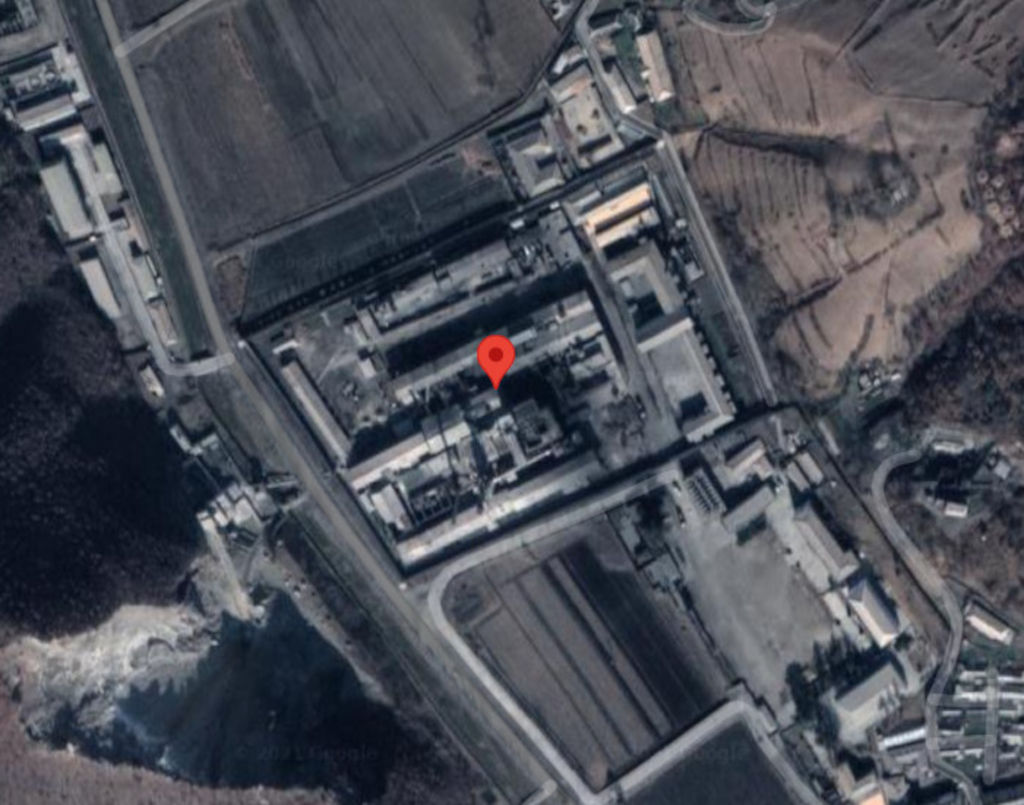
According to a former prisoner, an average of 500 prisoners die annually, mostly due to waterborne illnesses. Another former prisoner reported high death rates due to work accidents, malnutrition, and disease. Seriously ill prisoners are sent home on sick leave to reduce the apparent number of deaths in detention. In the limestone quarries the prisoners have to do hard labor in hazardous conditions, with prisoners often receiving or sustaining chest ailments and lung diseases from limestone dust. Moreover, as the prisoners are rarely allowed to wash their faces, many suffer from skin abrasions and infections.
Prisoners live in unsanitary conditions; they sleep on the floor in groups of 50 to 100 people, without bathing or changing their clothes. Food rations consist of only 50 g (2 oz) of corn and wheat and some cabbage soup per meal and all prisoners are seriously underweight. A former prisoner witnessed eight public executions during the eight months he was held in the camp. Rule violations are punished with reduced rations, extended sentences, and detainment in very small punishment cells. There is a criticism session every week, in which the prison officials criticise prisoners in front of a large group of prisoners.
Kaechon Kyo-hwa-so (Camp 1)
Kyo-hwa-so No. 1, Kaechon is also transliterated as Gaechon, which is located in Yaksu-dong, Kaechon City and thought to be one of the oldest kyo-hwa-so prison camps. Estimated number of Prisoners: 4,000 to 6,000. Type of prisoners: Men, women, political prisoners, border crossers, genuine criminal offenders, Japanese-Koreans. Type of Labor: Textile production, Leather manufacturing. Kaechon Kyo-hwa-so (Camp 1) is not to be confused with Kaechon internment camp (Kwan-li-so Nr. 14), which is located 20 km (12 mi) to the south-east.
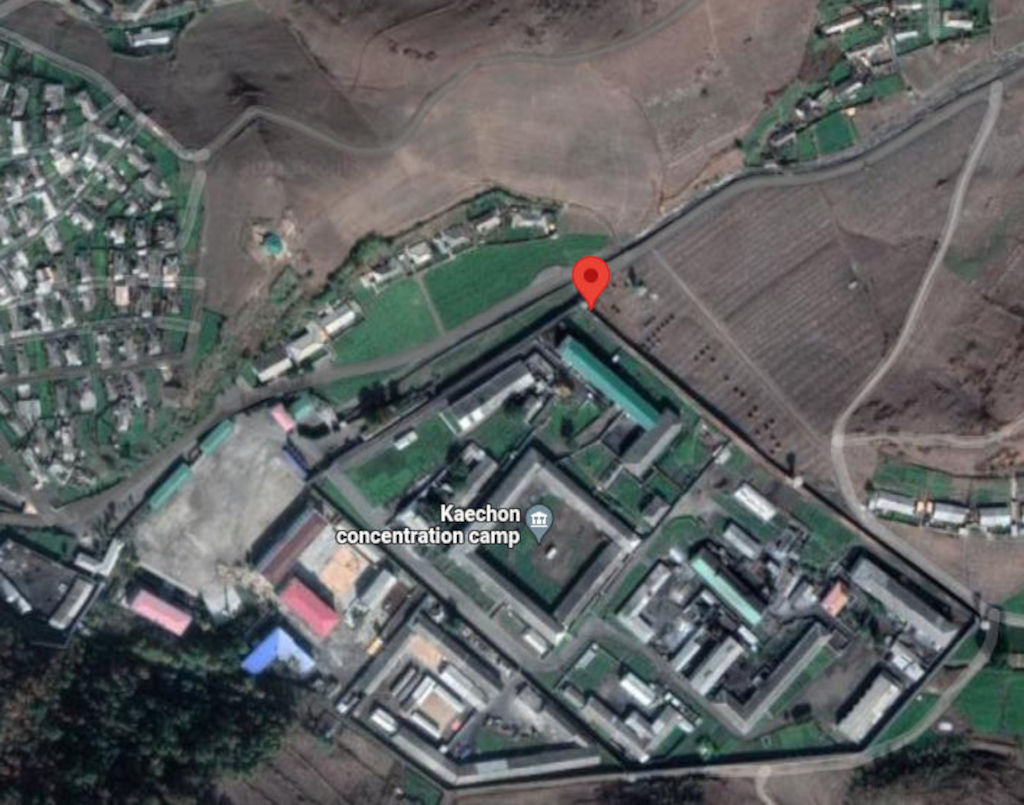
The human rights situation in the camp is described in detail by Lee Soon-ok in her testimony to the United States Senate Committee on the Judiciary. She explains how the prisoners have no rights and how they are treated at the mercy of the guards. The prisoners are forced to work around 18 hours per day at the camp's factories. If someone does not work quickly enough, he or she is beaten. Sometimes prisoners sleep at their workplaces to fulfill the production quota. All this involves frequent work accidents and many prisoners are crippled from the work or from torture.
Former Prisoners (Witnesses):
- Lee Soon-ok (1987–1992 in Kaechon) was imprisoned on alleged embezzlement of state property, when she refused to put material on the side for her superior. She was sentenced to 13 years in a prison camp, but released earlier under a surprise amnesty.
- Ji Hae-nam (1993–1995 in Kaechon) was imprisoned on disruption of the socialist order, as she sang a South Korean pop song and was denounced by a neighbor. She was sentenced to 3 years in a prison camp, but released after 2 years and 2 months
Prisoners are forced to sleep in a room with 80 to 90 people in 30 square metre (322 square feet) flea-infested rooms. Prisoners are only occasionally allowed to use the toilet (one for about 300 people) and may only take a shower after several months. Diseases like paratyphus are common, resulting from the bad nutrition. Food rations are 100 grams of broken corn three times a day and a salt soup. In case of rule violations food rations are reduced. Lee Soon-ok reported that prisoners even killed rats and ate them raw in order to survive.
There are 78 punishment cells in the camp, each 60 cm (24 inches) wide and 110 cm (43 inches) high, where prisoners are locked up several days. Afterwards many of them are unable to walk and some even die. Prisoners are often beaten, kicked or whipped. Lee Soon-ok was tortured being forced to drink a large quantity of water until she fainted (water torture) and almost died. During her sentence she witnessed many types of torture. Pregnant women are forced to have abortions by injections. Lee Soon-ok witnessed babies born alive being murdered directly after birth.
Sariwon Kyo-hwa-so (Camp 6)
Kyo-hwa-so No. 6 Sariwon is a "reeducation camp" in Sariwon, North Hwanghae. It holds roughly 3,500-4,000 prisoners. Type of prisoners: Men, political prisoners. Type of Labor: Clothing and Shoe factory, farming, "model detention facility".
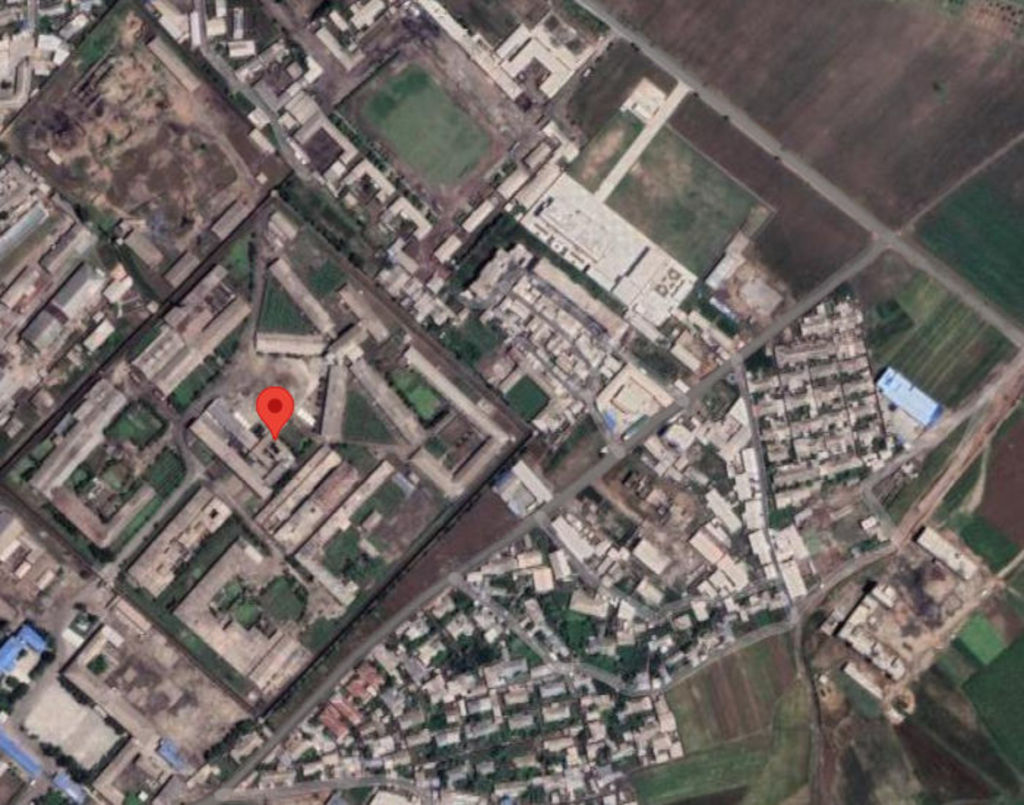
Sariwon was one of the earliest North Korean prison camps to become widely known about outside of North Korea because of the involvement of Amnesty International in the release of Ali Lameda and Jacques Sedillot. They were members in good standing in the Venezuelan and French, respectively, communist parties.
In 1967, both were recruited to Pyongyang by the North Korean Foreign Ministry to translate the writings of Kim Il-sung into Spanish and French. Lameda was a poet and author whose writings were well known throughout Latin America.
Onsong Kyo-hwa-so (Camp 12)
The Onsong concentration camp was an internment camp in Changpyong, Onsong County, North Hamgyong, North Korea. It housed approximately 15,000 political prisoners. The camp was officially known as Concentration Camp (Kwan-li-so) No. 12. Although information about the camp is scarce, two defectors have alleged the forcible suppression of a large riot in May 1987 at the camp.
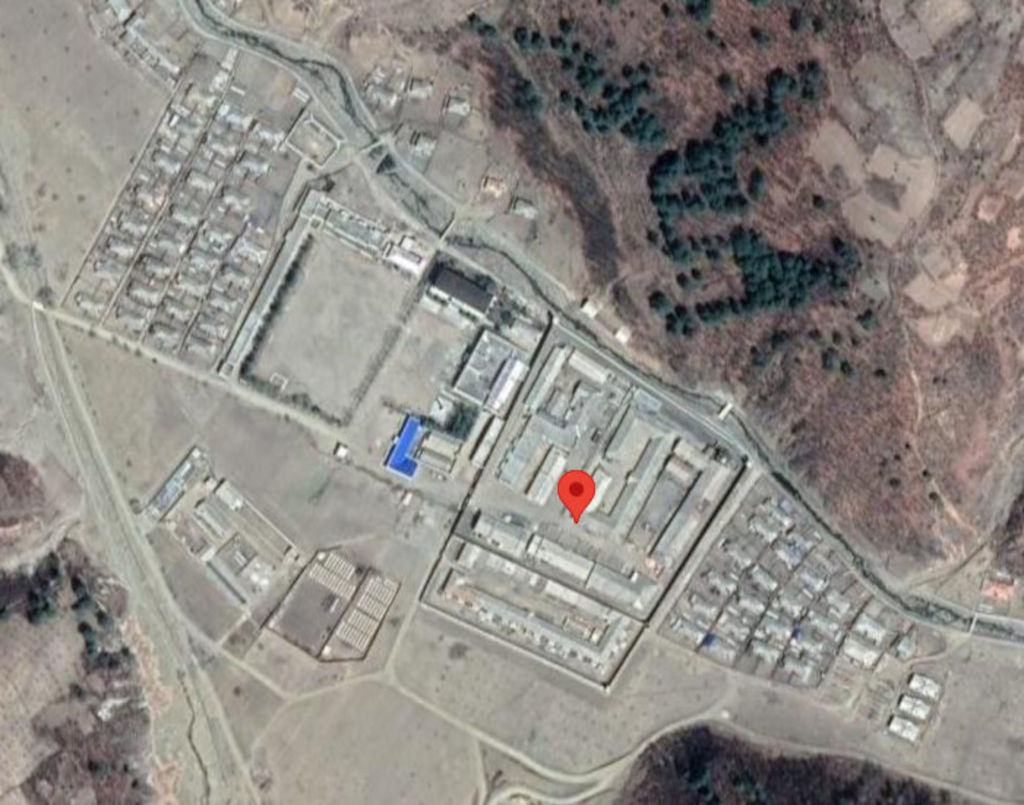
According to the testimony of Ahn Myong-chol, a guard at a similar camp, and Mun Hyon-il, a nearby resident, the riot started when one political prisoner at the camp killed a guard in protest of the guard's treatment of another prisoner; he was then joined by 200 others at the scene who overcame another guard. At the height of the riot, some 5,000 prisoners were openly in revolt.
Reinforced from a second camp, guards proceeded to open fire on the rioters with machine guns, the defectors have stated. Reports on the number of dead vary; the defectors claim all rioters were executed, while a third defector previously involved with the North Korean security services describes being told of the execution of only a third. The camp was closed in 1989, a decision thought to be because of its proximity to the border with China. The prisoners were then transferred to Hoeryong concentration camp.
Tongrim Kyo-hwa-so (Camp 2)
Kyo-hwa-so No. 2 Tongrim is a "reeducation camp" in Tongrim County, North Pyongan. Its number of prisoners and its state of operation are unknown.
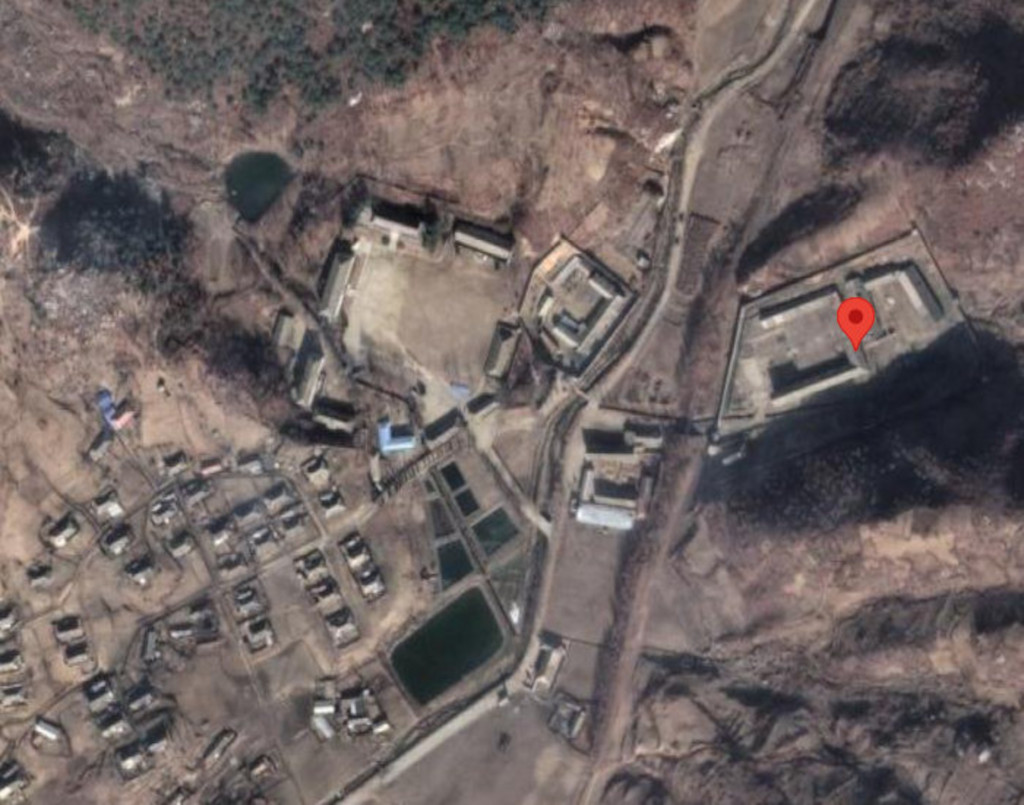
This location has not been confirmed by HRNK prisoner testimony. It has been listed in NKDB reports in 2011 and 2016, as well as KINU reports in 2014 and 2016.
Detention
Otto Warmbier
Otto Frederick Warmbier was an American college student who was imprisoned in North Korea in 2016 on a charge of subversion. In June 2017, he was released by North Korea in a vegetative state and died soon afterward. Warmbier entered North Korea as part of a guided tour group on December 29, 2015. On January 2, 2016, he was arrested at Pyongyang International Airport while awaiting departure from the country. He was convicted of attempting to steal a propaganda poster from his hotel, for which he was sentenced to 15 years' imprisonment with hard labour.
Shortly after his sentencing in March 2016, Warmbier suffered a severe neurological injury from an unconfirmed cause and fell into a coma, which lasted over a year. North Korean authorities did not disclose his medical condition until June 2017, when they announced he had fallen into a coma as a result of botulism and a sleeping pill. He was freed later that month, still in a comatose state after 17 months in captivity. He was repatriated to the United States and arrived in Cincinnati, Ohio on June 13, 2017. Warmbier never regained consciousness and died on June 19, 2017, six days after his return to the United States, when his parents requested his feeding tube be removed.
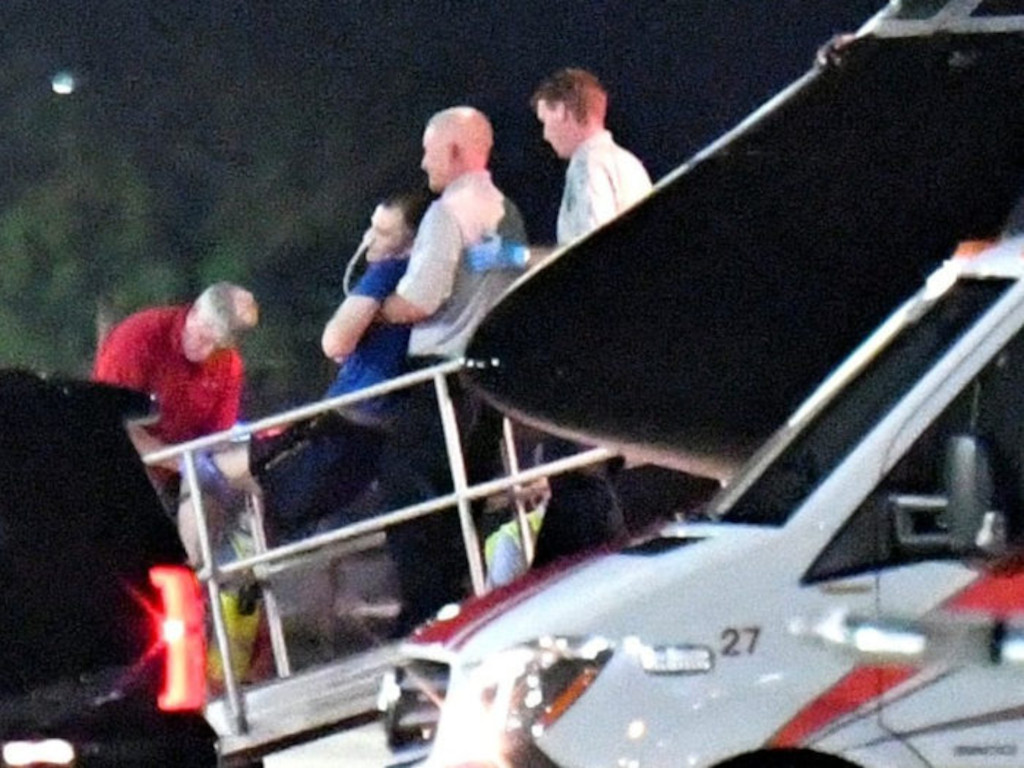
A coroner's report stated that he died from an unknown injury causing lack of oxygen to the brain. In June 2017, U.S. President Donald Trump condemned Kim Jong-un's “brutal” regime and described Kim as a “madman” after the death of American student Otto Warmbier who had been imprisoned during a visit to North Korea. In 2018, a U.S. federal court found the North Korean government liable for Warmbier's torture and death, in a default judgment in favor of Warmbier's parents after North Korea did not contest the case.
Kim Sang-duk
Kim Sang-duk, also known as Tony Kim, is a Korean-American professor who was detained in North Korea for 382 days. On May 9, 2018, it was reported that Kim was released from custody. Before being detained, Kim taught accounting at the Business Administration School of Yanbian University of Science and Technology (YUST) in the northeastern Chinese city of Yanji, near the China–North Korea border. According to Voice of America Korea reports, he was a regional director in charge of transporting foreign aid materials to several areas affected by the 2016 floods in North Korea, and his humanitarian work has gone on for more than 10 years.
On April 22, 2017, Kim and his wife were detained, and Kim was subsequently arrested at Sunan International Airport in Pyongyang as he was waiting to board a flight. In May 2017, Kim was allegedly accused of "committing criminal acts of hostility aimed to overturn [North Korea]." Kim was one of three Americans who were released from detention in North Korea in May 2018 in advance of a U.S.-North Korea summit. The others are Kim Dong-chul and Kim Hak-Song. At the time of his arrest, Kim had completed a one-month assignment as a guest lecturer in international finance and management at the Pyongyang University of Science and Technology (PUST), a YUST sister institution, according to the chancellor of PUST, Park Chan-mo.
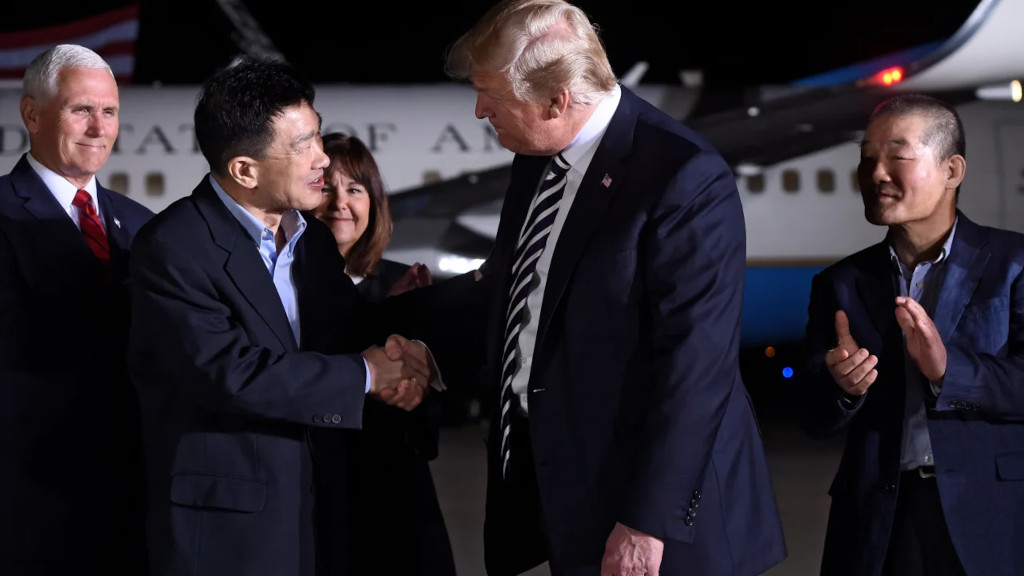
"We would like to express our deep appreciation to the United States government, President Trump, Secretary Pompeo, and the people of the United States for bringing us home...We thank God, and all our families and friends who prayed for us and for our return. God Bless America, the greatest nation in the world".
North Korean authorities did not immediately announce the reason for Kim's arrest. He had not been returned to the United States when the Olympic Games occurred in Pyeongchang South Korea during 2018, although a spokesperson for the United States State Department informed the news media: "We are working to see U.S. citizens who are detained in North Korea come home as soon as possible.". On May 9, 2018, several news outlets reported that Kim and fellow American detainees Kim Dong Chul and Kim Hak Song had been granted amnesty following a meeting between Supreme Leader Kim Jong-un and United States Secretary of State Mike Pompeo in Pyongyang to discuss details of the planned summit between Kim and President Donald Trump.
Kim Dong Chul
Kim Dong Chul (born 1953) is a Korean-American businessman who was imprisoned by the government of North Korea (DPRK) in October 2015 and sentenced to 10 years of hard labor for alleged espionage. Kim Dong Chul is a naturalised U.S. citizen of Korean origin. Once a resident of Fairfax, Virginia, Kim had been living in China with his wife, and owns a business in a special economic zone of the DPRK. It has been claimed that Kim was a Christian, and involved in missionary work.
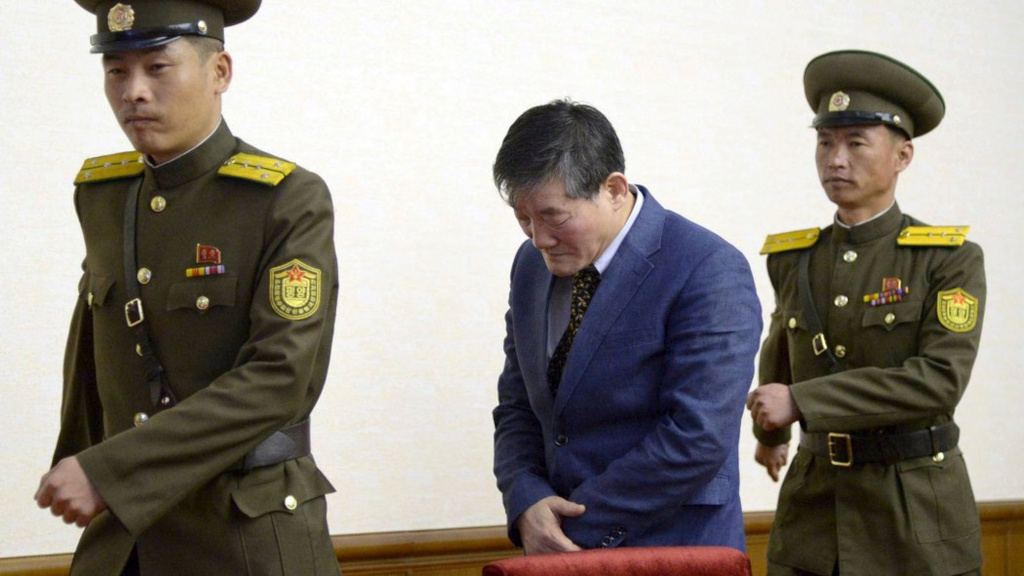
Kim was arrested in October 2015. His status was not publicly known until January 2016, when DPRK introduced him to a CNN crew visiting Pyongyang. CNN was allowed to interview Kim, but only through an interpreter. In March 2016, he appeared at a government-arranged news conference in Pyongyang and "apologised for trying to steal military secrets in collusion with South Koreans"; the South Korean authorities have denied any involvement. Kim's arrest and captivity, according to Russell Goldman of The New York Times, followed a pattern also seen with other detentions of U.S. nationals by North Korea: "A forced confession, a show trial, a sentence to years of hard labor with little chance of appeal.".
In an interview with NK News published on July 29, 2019, Kim admitted that he was spying for the American CIA and South Korean NIS since 2009.
Merrill Newman
In October 2013, Newman left his home in Palo Alto, California, for North Korea as part of a nine-day trip organised by Juche Travel Services, a travel agency that specialises in trips to North Korea. According to family members, Newman had generally been enjoying his trip and had communicated with them via telephone and postcards. On October 26, after boarding an Air Koryo airliner in Pyongyang on which he was scheduled to depart the country, Newman was removed by a single, uniformed official. Newman's traveling companion reported the arrest to U.S. officials via telephone upon the aircraft's arrival in Beijing later that day.
On November 29, the Korean Central News Agency (KCNA) released a video showing Newman signing a letter of apology and confession for war crimes committed during the Korean War. According to the accompanying report, the video had been recorded the preceding November 9. It went on to state that Newman had "masterminded espionage and subversive activities against North Korea and in this course he was involved in killings of service personnel of the Korean People's Army and innocent civilians" and that, during his visit, Newman had been found with an e-book containing subversive material.
The KCNA story also reported that Newman said he had served during the Korean War as a military adviser to the "Kuwol unit of the U.N. Korea 6th Partisan Regiment" and had asked his government tour guides to help him contact surviving members of the Kuwol Partisan Comrades-in-Arms Association. (United Nations Partisan Infantry Korea units were clandestine, special forces groups that operated during the Korean War and whose activities were not publicly acknowledged until 1990.). Kim Heyon, a former member of Newman's Korean War military unit, said that the irregular warfare engaged in by the partisan units had left Newman a permanently marked man in North Korea: "They detained him because he served in the Kuwol regiment. He is just a very bad guy for them."
On December 7, Newman was released. After flying from Pyongyang to Beijing, Newman met with U.S. Embassy officials, who bought him a ticket to San Francisco International Airport; a medical officer provided him with medications, and cleared him to fly. Newman boarded the flight the same day, declining an offer from Vice President Joe Biden, who was touring East Asia at the same time, to take a later flight out of Seoul on Air Force Two. After returning to the United States, Newman declined interview requests from media but casually remarked he had been well taken care of and held in comfortable conditions during his detention. Newman did not immediately retract his written confession, however, and "smirked" at a reporter who asked him about it.
In a subsequent written statement released by Newman's family, Newman declared his confession had been coerced, writing that "the words were not mine and were not delivered voluntarily.". In the same statement, however, Newman confirmed the veracity of the earlier KCNA report that he had requested his North Korean tour guides put him in contact with former anti-communist insurgents, but claimed it was for reasons of "curiosity" and his intention in making contact with guerrilla fighters had been "misinterpreted ... as something more sinister.". In 2014, journalist Mike Chinoy published an e-book about Newman's detention, The Last P.O.W.
Kidnap
Regarding the alleged abduction of Japanese nationals, on September 17, 2002, the North Korean Government officially admitted to the kidnapping of 13 Japanese citizens at a meeting between North Korean leader Kim Jong Il and Japanese Prime Minister Junichiro Koizumi. Yoichi Shimada, a Fukui University professor in Japan, states that North Korea appeared to abduct foreign citizens to:
- Eliminate witnesses who happened to run into North Korean agents in action.
- Steal victims' identities and infiltrate agents back into the countries concerned.
- Force abductees to teach their local language and customs to North Korean agents.
- Brainwash them into secret agents; the fishermen hardly had access to valuable intelligence, but they still could be trained as spies and sent back to the South.
- Use abductees' expertise or special skills.
- Use abductees as spouses for unusual residents in North Korea, especially lone foreigners such as defectors or other abductees.
These six patterns are not mutually exclusive. Especially numbers 2, 3, and 4 derive from Kim Jong Il's secret order of 1976 to use foreign nationals more systematically and thereby improve the quality of North Korean spy activities, contributing to his "localisation of spy education.". Further, better-educated people could be employed by the institutions responsible for waging propaganda campaigns against the South in, say, their broadcast facilities.
North Korean abductions have not been limited to northeast Asia and many documented abductees have been kidnapped while abroad, making the issue of serious concern to the international community.
- On April 5, 1971, Yu Sung-gun, a South Korean diplomat stationed at the South Korean embassy in West Germany, was abducted by North Koreans while in West Berlin.
- In June 1979, North Korean agents abducted South Korean teacher Ko Sang-moon in Norway, who had taken a taxi and stated his destination was "Embassy of Korea" but the driver took him to the embassy of the wrong country.
- In August 1987, Lee Chae-hwan, a South Korean student enrolled in the United States at the Massachusetts Institute of Technology was abducted by North Koreans while on a visit to Austria.
Ali Lamada and Jacques Sedillot
Ali Lamada and Jacques Sedillot were recruited in 1967 by the DPRK Ministry of Foreign Affairs and placed in the Department of Publications to translate the writings of Kim Il-sung into Spanish and French respectively. Lamada was an active member of the Venezuelan Communist Party, and his poetry and books were well known in the Spanish-speaking world. Both Lamada and Sedillot were arrested in September 1967. Sedillot was accused of being a French imperialist spy. No charges were initially brought against Lamada, who was simply arrested and coerced to confess to spying by means of solitary confinement in a 2-meter by 1-meter cell (7 feet by 3 feet by 10 feet) in the Ministry of Interior for a year on below subsistence level food rations. During this time, he lost 22 kilograms (more than 50 pounds) and his body became covered with sores.
Lameda suffered from paralysis in his left leg due to the long hours of sitting in a fixed position, while a tumor developed on his back. But the harsh conditions in North Korean prison took a greater toll on the elderly ex-colonel Sedillot. He passed away in Pyongyang on Jan. 6, 1976, according to Lameda.
After a year, Lamada was returned to his residence in Pyongyang and placed under house arrest but was picked up two months later and sentenced to twenty years of forced labour for being a spy. He was driven some three hours from Pyongyang and thrown into a punishment cell in a prison camp, where, handcuffed for three weeks, he slept on the floor without a blanket or mattress in freezing temperatures. Transferred to the main prison-camp building, he was locked in unheated rooms and his feet suffered frostbite. His toenails dropped off, and his feet became covered with sores. From guards, he learned that the name of the prison camp was Sariwon, where some 6,000 to 8,000 prisoners worked twelve hours per day assembling jeep parts. A doctor told Lamada that there was a special section of the prison camp where 1,200 sick persons were held.
“They killed everything except my memory"
While imprisoned at Sariwon prison labour camp [Camp 25], Lamada learned from guards and “order-lies,” who were privileged prisoners, some of whom had been held previously in other prison labour facilities, of approximately twenty other prison labour camps holding, Lamada calcu-lated, at that time roughly 150,000 prisoners altogether.The government of Venezuela and the President of Romania intervened on behalf of Lamada, and both he and Sedillot were released in May 1974. Sedillot died in Pyongyang of prison-related illnesses before he could return to France. Lamada recuperated in Eastern Europe before returning to Venezuela, where he published his account of his experience in the North Korean prisons and the Sariwon prison labour camp.
Shin Sang-ok
Shin Sang-ok (October 11, 1926 – April 11, 2006) was a South Korean film producer and director with more than 100 producer and 70 director credits to his name. His best-known films were made in the 1950s and 60s, when he was known as The Prince of South Korean Cinema. He received the Gold Crown Cultural Medal, the country's top honour for an artist. He is also known for having been kidnapped by the late North Korean leader, Kim Jong-il, for producing critically acclaimed films. In 1978, Shin's former wife, Choi Eun-hee, an actress who starred in many of his films, was kidnapped in Hong Kong and taken to North Korea. Shin came suspected of causing her disappearance and when he travelled to Hong Kong to investigate, he was kidnapped as well.
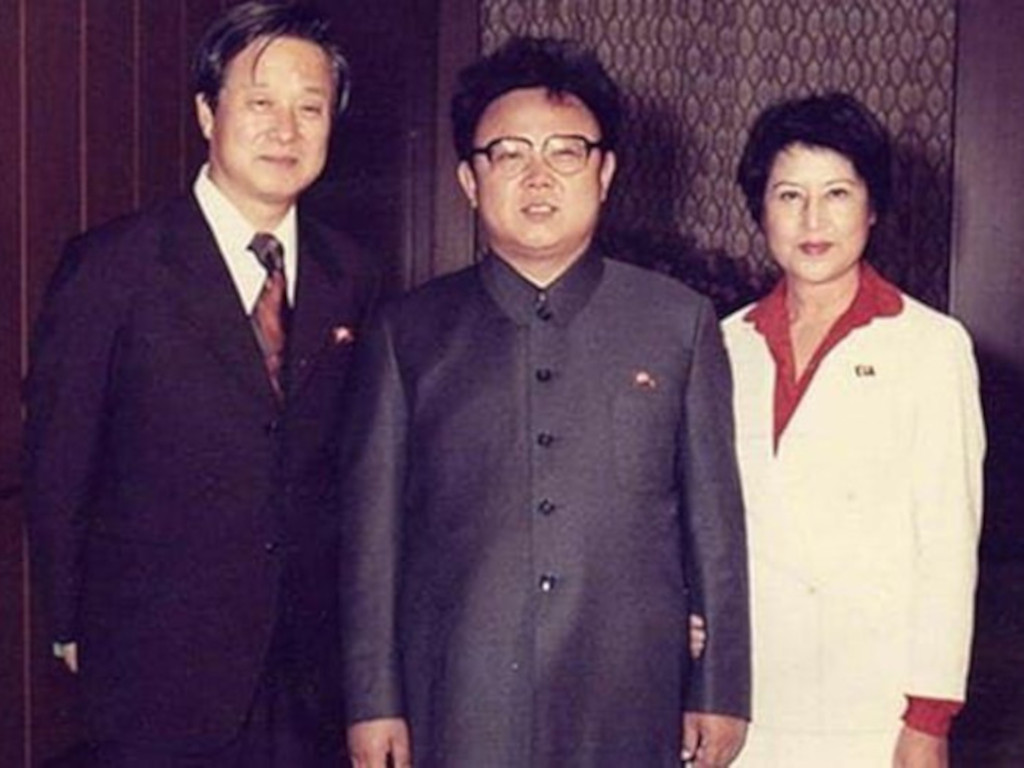
The kidnappings were on orders of future leader Kim Jong-il, who wanted to establish a film industry for his country to sway international opinion regarding the views of the Workers' Party of Korea. Shin was put in comfortable accommodation, but after two escape attempts was placed in a prison for over two years. Once his re-education in North Korean ideology was thought complete, he was taken to Pyongyang in 1983 to meet Kim Jong-il and learn why he had been abducted to North Korea. His ex-wife was brought to the same dinner party, where she first learned that Shin was also in North Korea. They remarried shortly afterwards, as suggested by Kim Jong-il.
From 1983 on, Shin directed seven films, with Kim Jong-il acting as an executive producer. The last and best-known of these films is Pulgasari, a giant-monster film similar to the Japanese Godzilla. In 1986, eight years after his kidnapping, Shin and his wife escaped while in Vienna for a film festival. They managed to obtain political asylum from the US embassy in Vienna, and Kim Jong-il became convinced that the couple had been kidnapped by the Americans. Shin and his wife lived covertly for two years in Reston, Virginia, under American protection and authorities debriefed the couple about Kim Jong-il and their experience in North Korea.
David Louis Sneddon
David Louis Sneddon is an American university student who disappeared in Yunnan Province, China after traveling alone through Tiger Leaping Gorge. Over 12 years later, on August 31, 2016, the Abductee's Family Union of South Korea claimed that it had gathered intelligence demonstrating Sneddon had been abducted by North Korean agents and taken to North Korea where he became the personal English language tutor to Kim Jong-un. The official position of the Chinese Government is that Sneddon died after falling into the Jinsha River, which passes through Tiger Leaping Gorge, although no body has ever been recovered.
The United States eventually adopted the Chinese Government's position. However, after discovery of compelling evidence that Sneddon was abducted by the North Korean regime, the U.S. House of Representatives unanimously voted on September 28, 2016, to direct the U.S. State Department and all other intelligence agencies to reopen the investigations into Sneddon's whereabouts. The U.S. Senate passed a similar resolution by unanimous vote more than two years later on November 29, 2018. North Korea denies its involvement in Sneddon's disappearance. Local news sites say that Sneddon is married to Kim Eun Hye and goes by the name of Yoon Bong Soo.
Megumi Yokota
Megumi Yokota is a Japanese citizen who was abducted by a North Korean agent in 1977 when she was a thirteen-year-old junior high school student. She was one of at least seventeen Japanese citizens kidnapped by North Korea in the late 1970s and early 1980s. The North Korean government has admitted to kidnapping Yokota, but has said that she died in captivity. Yokota's parents and others in Japan have publicly expressed the belief that she is still alive in North Korea and have waged a public campaign seeking her return to Japan.
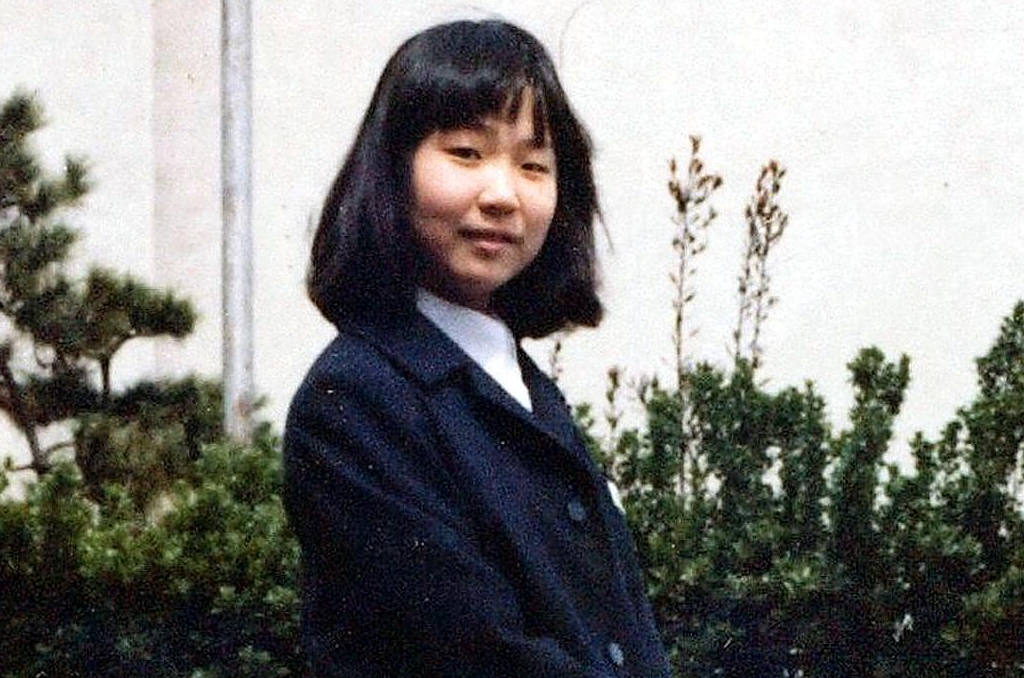
Megumi Yokota was abducted on 15 November 1977 at the age of thirteen while walking home from school in her seaside village in Niigata Prefecture. It's believed that she was abducted because she happened to witness activities of North Korean agents in Japan and so the agents wanted to silence her. North Korean agents reportedly dragged her into a boat and took her straight to North Korea to a facility, where she was taught the Korean language. She was eventually assigned to a university where North Korean spies were taught foreign languages, customs and practices. Here she taught Japanese to spies who were being trained to infiltrate Japan.
"We know it kidnapped a sweet 13-year-old Japanese girl from a beach in her own country to enslave her as a language tutor for North Korea's spies."
Also at the earlier facility were two South Korean high school students, aged 18 and 16, who had been abducted from South Korea in August 1977 and in August the next year, three more 16-year-old South Korean students were abducted and taken to the same facility. These included Kim Young-nam [ja], who would reportedly later marry Yokota. After many years of speculation and no new leads, in January 1997, information about Megumi's abduction was disclosed to Yokota's parents by Tatsukichi Hyomoto, a secretary to Diet member Atsushi Hashimoto, by a phone call. In 2002, North Korea admitted that she and others had been abducted, but claimed that she had committed suicide on March 13, 1994, and returned what it said were her cremated remains.
Yokota was alleged to have died at the age of 29. However, the death certificate provided in support of this assertion appears to have been falsified, and DNA tests on the remains said to be hers were not a positive match.
It is widely believed, especially in Japan, that Yokota is still alive. In November 2011 a South Korean magazine, Weekly Chosun, stated that a 2005 directory of Pyongyang residents listed a woman, named Kim Eun-gong, with the same birth date as Yokota. The directory gave Kim's spouse's name as "Kim Yong Nam". Japanese government sources verified on 18 November 2011 that they had reviewed the directory but had yet to draw a conclusion on the identity of the woman listed. Sources later indicated that Kim Eun-gong was actually Yokota's 24-year-old daughter. In 2012, it was reported that North Korean authorities were keeping Kim under strict surveillance.
In August 2012, Choi Seong-ryong stated that sources in North Korea had told him that Kim Eun-gong had been placed under the supervision of Kim Jong-un's sister, Kim Yo-jong, and that the North Korean government may be planning on using Yokota's daughter as a "card" in future negotiations with Japan. Reportedly, in 2010 the North Korean government offered to allow Yokota's parents to visit Kim Eun-gyong in a country "other than Japan" but the Japanese government and Yokota's parents were wary about the offer, suspecting it as a ploy by the North Korean government to seek an advantage in ongoing diplomatic negotiations.
Hijacking
Korean Air Lines YS-11
The Korean Air Lines YS-11 hijacking occurred on 11 December 1969. The aircraft, a Korean Air Lines NAMC YS-11 flying a domestic route from Gangneung Airbase in Gangneung, Gangwon, South Korea to Gimpo International Airport in Seoul, was hijacked at 12:25 PM by North Korean agent Cho Ch'ang-hŭi. It was carrying four crewmembers and 46 passengers (excluding Cho); 39 of the passengers were returned two months later, but the crew and seven passengers remained in North Korea. The incident is seen in the South as an example of the North Korean abductions of South Koreans.
According to passenger testimony, one of the passengers rose from his seat 10 minutes after takeoff and entered the cockpit, following which the aircraft changed direction and was joined by three Korean People's Air Force fighter jets. The aircraft landed at Sǒndǒk Airfield near Wonsan at 1:18 pm. North Korean soldiers boarded the aircraft afterwards, blindfolded the passengers, and instructed them to disembark. The aircraft was damaged beyond repair on landing. North Korea claimed that the pilots had flown the aircraft there to protest the policies of then-President of South Korea Park Chung Hee.
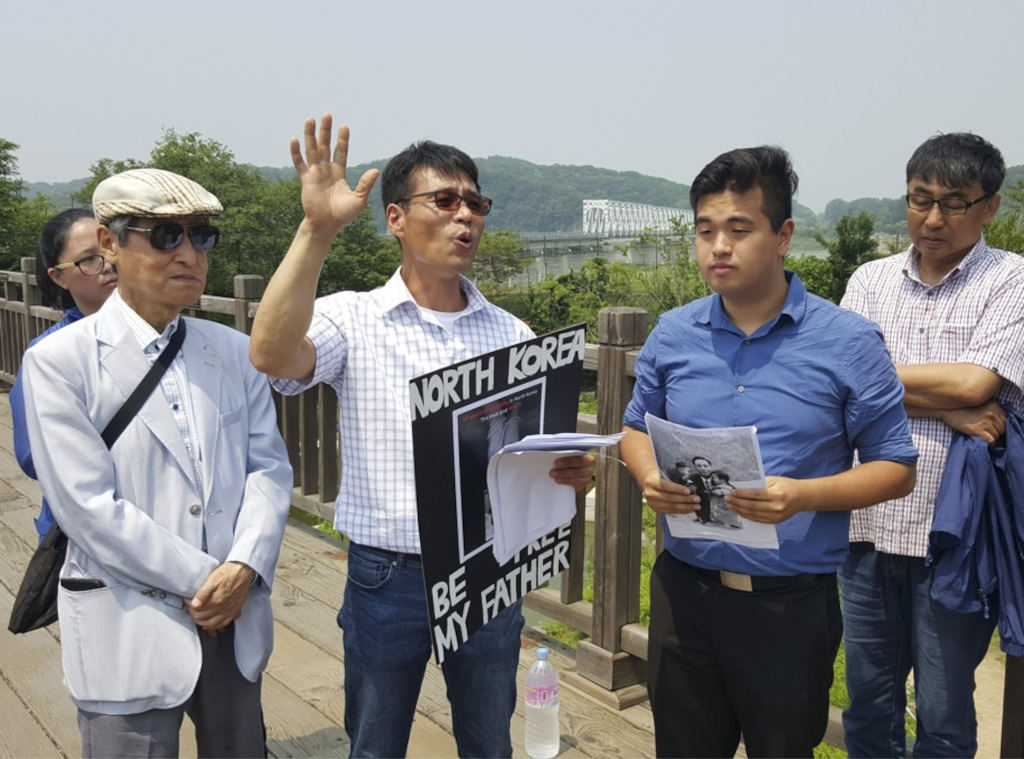
The passengers were subjected to attempts at indoctrination for up to four hours a day. The South Korean police initially suspected that the co-pilot conspired with two North Korean agents in the hijacking. The night after the hijacking, 100,000 South Koreans held a mass rally in freezing weather to protest about the hijacking, and burned an effigy of Kim Il Sung. On 25 December, North Korea proposed to hold talks on the matter. Talks were finally held in late January 1970. Sixty-six days after the incident, North Korea released 39 of the passengers on 14 February through the Joint Security Area at Panmunjom, but kept the aircraft, crew, and remaining passengers.
The statements provided by the released passengers refuted North Korea's claims that the hijacking was led by the pilots; instead, they pinned the blame on one of the passengers. One man claimed to have looked out the window of the aircraft despite instructions from the North Korean guards, and saw the hijacker being driven away in a black sedan. Another passenger was reported to have become mentally deranged as a result of his captivity, and lost the ability to speak.
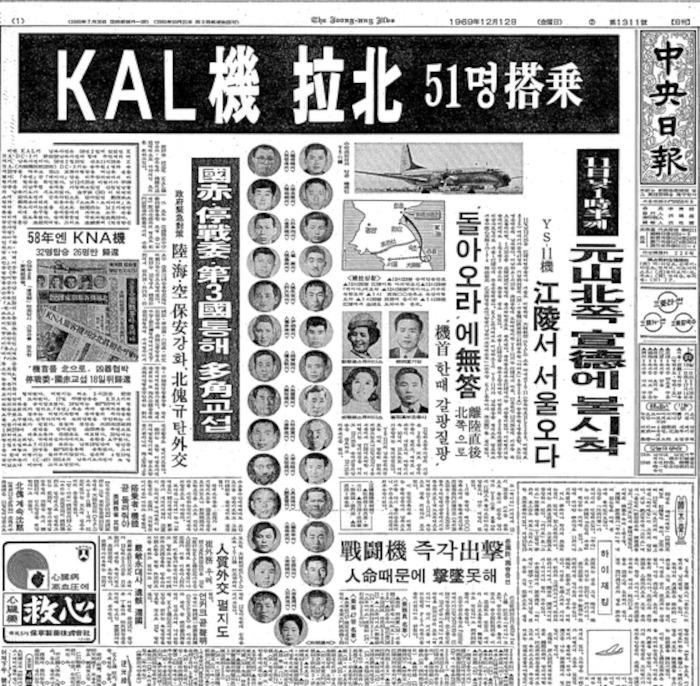
The fate of most of the unreturned passengers has not been confirmed. They were educated, upper-class people; Song Yeong-in formerly of the National Intelligence Service commented at the families' committee inaugural meeting in 2008 that they were probably retained by North Korea specifically for their propaganda value. Oh Kil-nam, who defected to the North for a time in 1986, said that he met the two flight attendants as well as the Munhwa Broadcasting Corporation employees Hwang and Gim employed making propaganda broadcasts to the South and that later he heard from his daughter that the captain and first officer were working for the Korean People's Air Force.
Korean Air Flight 858
Korean Air Flight 858 was a scheduled international passenger flight between Baghdad, Iraq, and Seoul, South Korea. On 29 November 1987, the aircraft flying that route exploded in mid-air upon the detonation of a bomb planted inside an overhead storage bin in the airplane's passenger cabin by two North Korean agents. The agents, acting upon orders from the North Korean government, planted the device before disembarking from the aircraft during the first stop-over, in Abu Dhabi, United Arab Emirates. While the aircraft was flying over the Andaman Sea to its second stop-over, in Bangkok, Thailand, the bomb detonated and destroyed the Korean Air Boeing 707-3B5C.
Everyone aboard the airliner was killed, a total of 104 passengers and 11 crew members (almost all were South Koreans). The attack occurred 34 years after the Korean Armistice Agreement that ended the hostilities of the Korean War on 27 July 1953. The two bombers were traced to Bahrain, where they both took ampules of cyanide hidden in cigarettes when they realised they were about to be taken into custody. The man died, but the woman, Kim Hyon-hui, survived and later confessed to the bombing. She was sentenced to death after being put on trial for the attack, but was later pardoned by the President of South Korea, Roh Tae-woo because it was deemed that she had been brainwashed in North Korea.
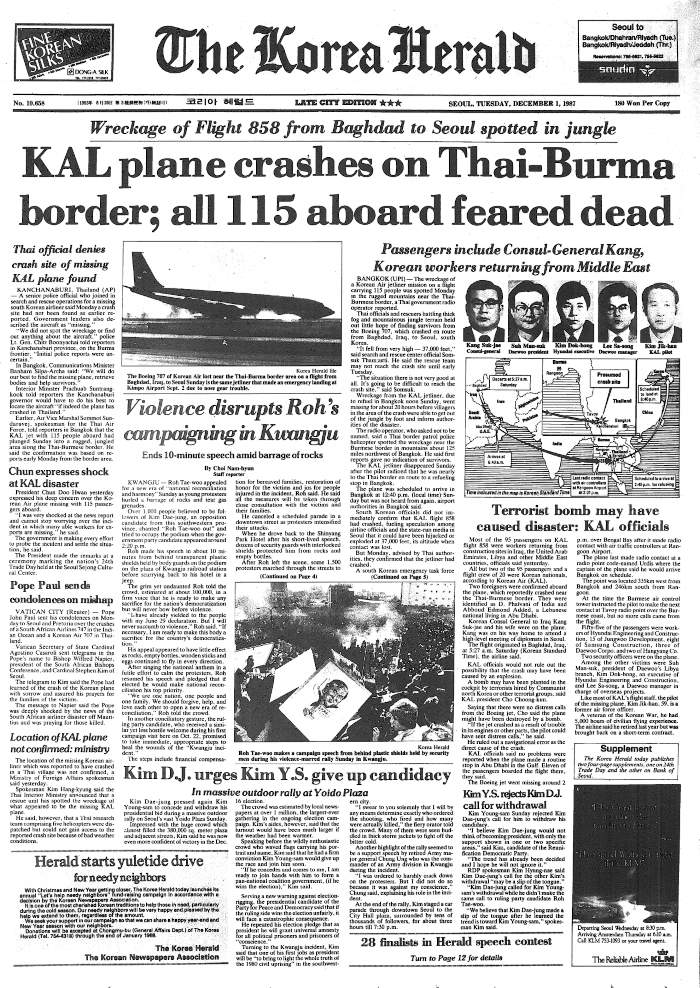
Kim's testimony implicated Kim Jong Il, who at that time was the future leader of North Korea, as the person ultimately responsible for the incident. The United States Department of State specifically refers to the bombing of KAL 858 as a "terrorist act" and, except between 2008 and 2017, has included North Korea on its State Sponsors of Terrorism list. Charles E. Redman, Assistant Secretary of State for Public Affairs, said in January 1988 that the incident was an "act of mass murder," adding that the administration had "concluded that the evidence of North Korean culpability is compelling. We call on all nations to condemn North Korea for this terrorist act."
Kim Jong Il became the leader of North Korea in 1994, succeeding his father. In 2001, right-wing activists and relatives of the victims killed in the attack demanded that Kim Jong Il be arrested for terrorism offences when he visited Seoul later in the year. Two petitions were filed against him, with the activists and relatives stating that there was strong evidence—namely Kim's testimony—to suggest he was ultimately responsible for the bombing. They also called for him to make a public apology for the incident and formally compensate the victims' families.
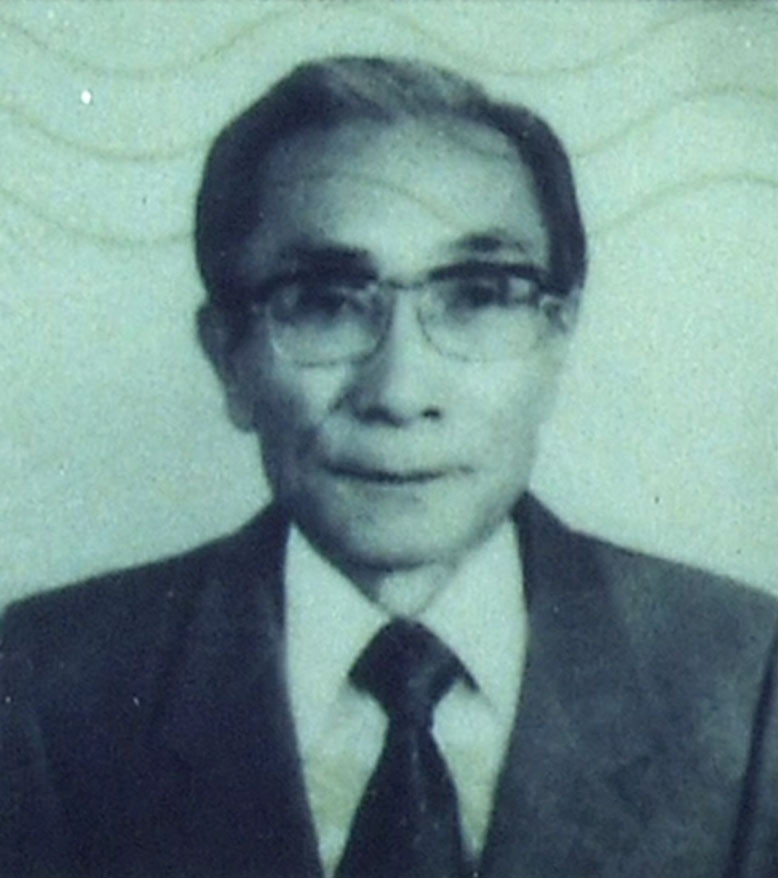
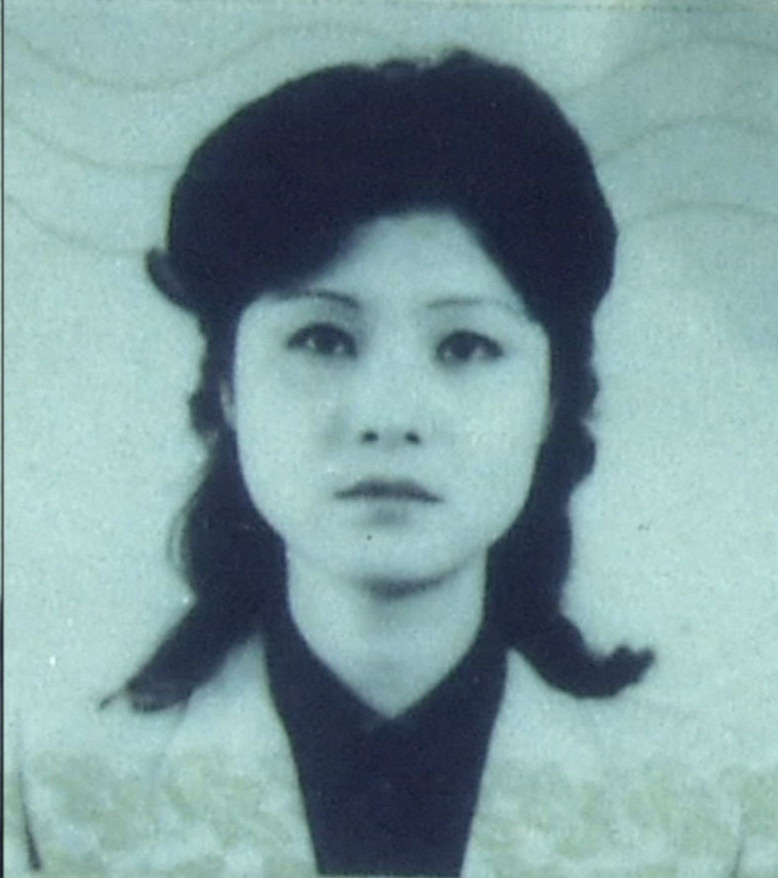
“She [Kim Hyon-hui] said she was trained as a secret agent for seven years and eight months, including a year in a clandestine camp deep in the mountains where she was taught martial arts, shooting, radio communications and how to survive in the wilderness.”.
Kim Hyon-hui later released a book, The Tears of My Soul, in which she recalled being trained in an espionage school run by the North Korean army, and being told personally by Kim Jong Il to carry out the attack. She was branded a traitor by North Korea and became a critic of North Korea after seeing South Korea. Kim now resides in exile, and under constant tight security, fearing that the North Korean government wants to kill her. It is also believed that Kim Jong Il masterminded the Rangoon bombing of 1983, in which North Korea attempted to assassinate South Korean president, Chun Doo-hwan.
